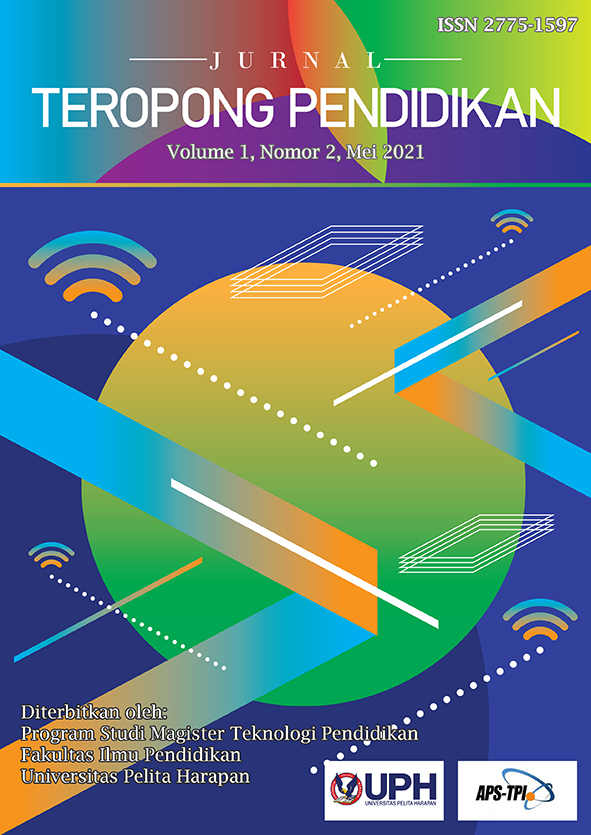PENGARUH MUSIK KLASIK DAN PREFERENSI PRIBADI TERHADAP TEST ANXIETY DAN HASIL TES MEMBACA KOMPREHENSIF SISWA [THE EFFECT OF CLASSICAL MUSIC AND PERSONAL MUSIC PREFERENCE ON TEST ANXIETY AND READING COMPREHENSION TEST RESULTS]
DOI:
https://doi.org/10.19166/jtp.v1i2.3458Keywords:
Classical music, personal music preference, musical preferences, reading comprehension test, test anxietyAbstract
Music is part of human life. Studies show that music influences psychological, cognitive, behavior, and emotion sides of human being. Research shows that music also influences students’ performance on reading comprehension test and test anxiety level. The purpose of this study is to investigate the effect of classical and personal preference music on students’ reading comprehension test performance and test anxiety level at grade XII SMAK 4 PENABUR Jakarta. The experiment design of this study is Pretest Posttest Non-Randomly Assigned Design. The students in experiment group get a treatment that is listening to classical music fifteen minutes before and while doing reading comprehension test. Students in another experiment group get a treatment that is listening personal preference music fifteen minutes before and while doing reading comprehension test in English class. Mean obtained from pretest and posttest of experiment class will be compared with mean from pretest and posttest of control class to explain whether or not they are statistically different. The study shows that classical and personal preference music influence students’ reading comprehension performance and test anxiety. Study also shows that there is negative correlation between students’ test anxiety and reading comprehension performance.
References
Alderson, J. C. (2000). Assessing reading. Cambridge University Press. https://doi.org/10.1017/CBO9780511732935
Banoe, P. (2003). Kamus musik. Kanisius.
Berk, R. A. (2008). Use of technology and music to improve learning. https://images.pearsonassessments.com/images/NES_Publications/2008_12Berk_13012_1.pdf
Creswell, J. W. (2014). Research design pendekatan metode kualitatif, kuantitatif, dan campuran. Pustaka Pelajar.
DeMers, A. S. (1996). The effect of background music on reading comprehension test scores. [Master’s thesis, State University of New York]. Digital Commons @Brockport. http://digitalcommons.brockport.edu/ehd_theses/111
Ewen, D. (1968). The world of twentieth century music. Prentice Hall.
Gollin, G. (2016). A highly subjective, highly abbreviated, history of western (classical) music [PowerPoint slides]. Silo.tips. https://silo.tips/download/a-highly-subjective-highly-abbreviated-history-of-western-classical-music
Hall, J. C. (1952). The effect of background music on the reading comprehension of 278 eighth and ninth grade students. Journal of Educational Research, 45(6), 451-458. https://doi.org/10.1080/00220671.1952.10881962
Hallam, S., Price, J., & Katsarou, G. (2002). The effects of background music on primary school pupil’s task performance. Educational Studies, 28(2), 112-122. https://doi.org/10.1080/03055690220124551
Lilley, J. L., Oberle, C. D., & Thompson, J. G., Jr. (2014). Effects of music and grade consequences on test anxiety and performance. Psychomusicology: Music, Mind, and Brain, 24(2), 184-190. https://doi.org/10.1037/pmu0000038
McKay, P. (2006). Assessing young language learner. Cambridge University Press.
Sapp, M. (1999). Test anxiety: Applied research, assessment, and treatment interventions. University Press of America.
Soedarsono. (1992). Pengantar apresiasi seni. Balai Pustaka.
Woolley, G. (2011). Reading comprehension: Assisting children with learning difficulties. Springer. https://doi.org/10.1007/978-94-007-1174-7
Zeidner, M. (1998). Test anxiety: The state of the art. Kluwer Academic Publisher.
Downloads
Published
Issue
Section
License
Authors who publish with this journal agree to the following terms:
1) Authors retain copyright and grant the journal right of first publication with the work simultaneously licensed under a Creative Commons Attribution License (CC-BY-SA 4.0) that allows others to share the work with an acknowledgement of the work's authorship and initial publication in this journal.
2) Authors are able to enter into separate, additional contractual arrangements for the non-exclusive distribution of the journal's published version of the work (e.g., post it to an institutional repository or publish it in a book), with an acknowledgement of its initial publication in this journal.
3) Authors are permitted and encouraged to post their work online (e.g., in institutional repositories or on their website). The final published PDF should be used and bibliographic details that credit the publication in this journal should be included.





